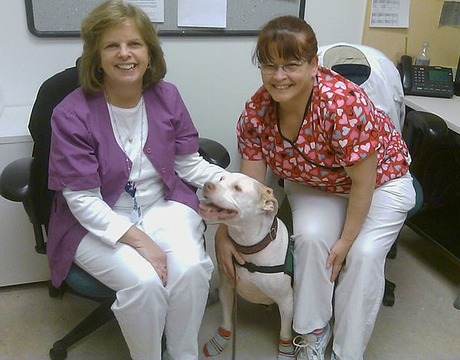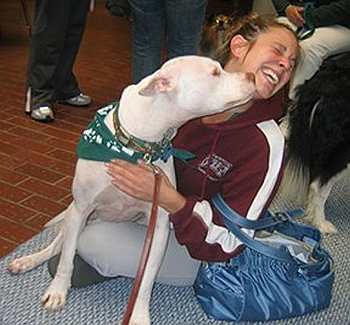By Amanda Clase, StubbyDog.org
In June of 2009 I was introduced to the world of Pit Bulls. My mom was driving to work and saw a huge black and white Pit Bull sitting on the side of the road. We already had four family dogs between the two of us, so she passed by hoping someone else would stop for the dog. Her heart got the better of her, however, and she returned to the spot about 40 minutes later to find the dog had not moved an inch. She seemed to be waiting for someone. When my mom invited her to come home, the dog jumped into the back of the car and waited to be chauffeured into her new life.
We decided that since I only had one dog living with me that this 1.5-year-old Pit Bull would stay with me until her guardian could be found. She and Samantha, my 9-month-old “pitador” (Labrador/Pit Bull mix) instantly became fast friends, and I fell completely in love with her before the first day was over. Not surprisingly, her guardian, who had likely dumped her on that road, never came to claim her, and Sydney became a permanent family member.
BDL Hits Home
I knew nothing about the breed and made no attempt to do any research since I felt all dogs were basically the same. This blissful ignorance however came crashing down on me when later that year I decided to move to Denver, Colorado, to go back to school. Talking to a Denver cab driver on the way back to the airport, I was devastated to learn that Pit Bulls were illegal in Denver. Back home I started doing my research and learned the horrors of breed-discriminatory legislation (BDL). I had already accepted the studentship in Denver but quickly made arrangements to live in the neighboring city of Aurora so that I could legally keep my dogs.
After a few years, I decided that therapy work would be a great way to showcase Pit Bulls in a positive light and joined a local organization that held training classes in Denver. I couldn’t bring Sydney to the classes, but Samantha looked Labrador enough that I could sneak her in. The organization didn’t agree with the breed ban and allowed me to train Sydney at home. The evaluator would come outside of Denver when the time came for the girls to take their final exam. Both girls passed with flying colors, and we were all ready to start visiting. The organization had an agreement with a hospice facility outside Denver city limits, but before I was able to start visiting, my father passed away unexpectedly, and the hospice facility felt it was unwise for anyone to volunteer if they’d had a recent loss of their own.
Soon after, I finished my education and moved on to Montana to further my career. I also decided to make another addition to my family and adopted Murphy, a 9-week-old Pit Bull puppy. Over the next year, I trained and socialized Murphy as much as I could and again decided that it was time to pursue therapy work with the dogs.
Breed Ambassadors
In July 2006 I drove an hour and a half to a Delta Society evaluation with Samantha and Sydney, now 8 years old, and 18-month-old Murphy. Sydney was the first to be evaluated and after we finished the last test, the evaluator turned to his volunteer helpers and said, “Now that is what a Pit Bull is supposed to be like! Next time you hear anything bad about this breed, remember what you saw here today!” Samantha and Murphy also passed with flying colors that same day. We spent the next couple of years visiting a local retirement home, and Murphy visited the University of Montana for their “Stress-Less” events for the students.
I will never forget our very first therapy visit. I had made arrangements with the retirement home to start their therapy dog program. Since they had never asked, I hadn’t offered the breed of dog I’d be bringing – I just gave them their Delta qualifications. One can imagine their surprise when I walked in with this huge black and white Pit Bull when they were expecting a more typical “family” dog. The residents were waiting in the lobby for our first visit, and Sydney immediately planted her huge head in the lap of the first person she saw. The woman was ecstatic and laughed and petted her, much to Sydney’s delight. Suddenly Sydney looked behind her and, as I turned, I saw a woman leaning forward from her wheelchair to pet Sydney’s back. She never said a word and only made that single stroke, but I saw tears in the eyes of every staff member in the room. I was told later that this woman had been at the home for five years and had never once made any effort to reach out to anyone until she stroked Sydney’s back. All my Pit Bulls were welcomed there from that point on. Sadly, over the next few years, Samantha and Sydney’s health deteriorated, and by 2010 I had lost both of them.

Murphy, now 7 years old, still carries on their great work and loves every minute of it. He even has his own business card! He was a favorite at the Virginia hospital at which we most recently volunteered. In the emergency room, he had what was dubbed “The Murphy Effect”: Big, macho EMTs would fall to the floor squealing like little girls at the opportunity to pet and play with Murphy. I can’t begin to count all the times patients or visitors have told me, “This is the first time I’ve ever petted a Pit Bull.”
Magnificent Murphy
One evening while passing through an empty waiting room outside the ICU, we heard a door open behind us. I didn’t think anything of it until Murphy suddenly turned and was determined to go back. A woman was coming out of the restroom obviously very upset. I hesitated to intrude on her privacy, but Murphy would not be denied! The sight of Murphy heading her way brought a small smile and she knelt down to greet him. She sat on the floor for several minutes with him in her lap (all 65 pounds of him) talking to him and stroking him, rarely saying a word to me. Eventually, her tears started again; embarrassed, she wrapped her arms around Murphy, hid her face in his neck and kissed him before getting up to leave. Murphy absolutely knows who needs his special kind of therapy the most, and this woman definitely needed him at that moment.
Murphy’s comical, joyful expression and the little socks he wears to provide him traction on the slick hospital floors entices folks to invite him over and also gives me the opportunity to educate people about Pit Bull type dogs. However, it is his personality and love of his work that has changed more minds than I ever will.









